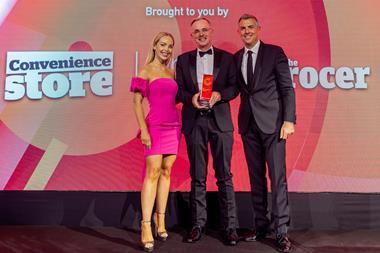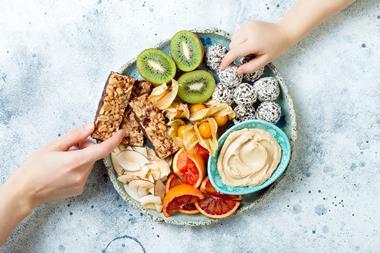Four C-Store Champions reveal how they get the most from fruit & veg
David Nice, Nisa, Maylandsea, Essex
David’s store was one of 30 that took part in a 13-week fruit & veg trial with Nisa to improve category sales by expanding his range. He discovered that customers wanted more than just basic bananas and potatoes.
Tim Farmer, Eurospar Broomhill, Sheffield
Staff at Tim’s store are encouraged to upsell at the till point in order to increase people’s interest in promotional fruit & veg. He has had pricemarked fruit & veg in store for the past 15 months.
Simon Biddle, Biddles Convenience Store, Redditch, Worcestershire
Having previously been unaffiliated, Simon has made the decision to up his game by joining the Simply Fresh symbol group. As the name implies, fresh fruit & veg is a core focus for the symbol group.
Tony Scott, Scott’s Budgens, Bampton, Oxon
Tony knows that half the battle with fruit & veg is ensuring that it looks great and captures customers’ imaginations. He is about to introduce wicker-style baskets into his store to give his fruit & veg display a rural feel.
How is your fruit & veg offering performing at the moment?
David: We’re about 18% up year on year. We did a project with Nisa to improve fruit & veg and they recommended their full range, which has really made a difference.
Tim: Our fruit & veg sales are actually slightly down, but this isn’t a reflection on the category itself. It is because trade has been affected by the local university’s halls of residence moving further away from the store.
Simon: The category has always done very well for us because we always keep our fruit and veg looking fresh and appealing - that’s the key to getting people to buy into it.
Tony: Our sales are slightly up on last year. Budgens stores have always been strong on fruit & veg, so we are unlike other symbol stores which have only just started realising the potential of the category.
What are the best-selling products across your fruit & veg range?
David: Potatoes and bananas are good sellers. Prepacked mash and sweet potatoes are also surprisingly popular.
Tim: Our best-sellers are core range fruit & veg, such as soft fruits and potatoes, but items such as fresh herbs also perform well for us.
Simon: Potatoes, bananas and tomatoes are main best-sellers. We have found people are now buying more fruit & veg on a day-to-day basis to keep it fresh for longer and to reduce waste, and are choosing particular vegetables that are easier to prepare.
Tony: Bananas and potatoes are the best-sellers here, but other items that are particularly popular are fennel, smoked garlic, black garlic and celariac. Bagged salads and fresh herbs also do well.
Where do you source your fruit & veg from?
David: All our fruit & veg is sourced from Nisa.
Tim: Blakemore supply all our fruit & veg.
Simon: I go to the wholesale market in Birmingham three to four times a week at 4.30am to source the best possible produce.
Tony: We get everything from Budgens.
How has your fruit & veg fixture changed in recent months?
David: Last year we didn’t stock products such as sweet potatoes and pre-packed mash. We didn’t think we could sell them, believing we’d end up with too much wastage. We also stocked a limited range of fresh herbs, whereas now we stock a full range. In addition, we have started selling loose fruit by the counter, housed in a Change4Life cardboard unit.
Tim: In recent months we have run fewer promotions on fruit & veg, and put a greater focus on more deep-cut deals at rounded price points.
Simon: In the past few weeks we have refurbished the shop with Simply Fresh. We have gone for a more upmarket look with our displays and are harking back to the old days with wicker baskets and chalkboard pos material.
Tony: We’ve just introduced some £1 offers on bagged apples and nets of lemons and limes. They all give a 20%-plus margin.
How do you display your fruit & veg to make it as appealing as possible?
David: We use bright yellow Change4Life pos material, and display produce in black plastic trays, which look neat and are hygienic.
Tim: It’s all tray-filled and we replenish the fixture regularly. We also try to put contrasting colours next to each other to create good standout.
Simon: We always trim and prep our veg before it goes on display, and rotate and take off any tired-looking produce.
Tony: Budgens provides ample pos material, and from time to time we use hand-written signs to create a market feel.
What are the most effective promotions and display techniques to run on fruit & veg?
David: I think pricemarking is effective. Also, moving fruit & veg to the checkout and other areas around the store to encourage impulse sales helps.
Tim: We’ve found the most effective tool is to upsell products that are on promotion. In recent weeks, staff have upsold prepacked bananas and fresh pineapples at £1, and 500g packs of grapes for £2. It all works really well.
Simon: We run strawberries and cream offers in summer, cooking sauces with veg in winter, and all year round we do link deals on salad accompaniments such as olives and salad dressings.
Tony: A straight price discount is better than a multi-buy. They’re easier to display than mix and match deals and make a bigger impact.
Who is buying your fruit & veg?
David: Plastic pots of grab-and-go fruit are bought by both kids and office workers. Elderly people like to buy fruit & veg loose as they’re on their own and they need only small portions.
Tim: It’s across the board, really - all sorts of customers buy into fruit & veg.
Simon: We have a varied clientele, both young and old.
Tony: It’s across the board. The old folk like the choice that loose products offer, but all types of customers buy into fruit & veg.
Do you think all retailers would benefit from selling fruit & veg?
David: Yes, most c-stores generally do well in fruit & veg, although they could all improve in terms of range.
Tim: Everyone would benefit because the margins are so good - 35-40%.
Simon: If you have a good-looking fruit & veg display, it helps to sell other products. But they need to keep on top of it at all times.
Tony: I’ve been in business since 1980 and we’ve always done well from fruit & veg, even more so since joining Budgens. I would say that every retailer can do fruit & veg, but to whatever extent they do it they need to do it well and be prepared to deal with losses to start with.
If a retailers’ fruit & veg fixture isn’t performing, then what advice would you offer them?
David: Availability, range, and cleanliness are crucial. You’ve got to get customers wanting to buy from your fixture, so it has to be full. If someone comes in to buy a meal, such as spaghetti bolognese, they’ll pick up the chopped tomatoes, the spaghetti, and the mince, but if they can’t find fresh mushrooms, they’ll leave the lot.
Tim: Sometimes you have to invest in the product in order to sell it. You have to speculate to accumulate. By encouraging customers to buy the products at a reduced price, they may well return at a later date and buy at full price.
Simon: They need to monitor it regularly and constantly remove any tired looking produce. It has to look as fresh as possible.
Tony: Really analyse what you’re selling – some products just won’t work in certain stores. Ensure that what you stock suits your customer base and keep it topped up. A full display gives you full sales.

Do you and your staff understand the fruit & veg fixture, or do you get expert help from outside?
David: We’ve had help from Nisa in terms of range, but we have a good understanding ourselves. We know you can’t sell out of things such as bananas, tomatoes and mushrooms.
Tim: Spar offers training, but the staff are knowledgeable. The guy who looks after the fruit & veg fixture has 25 years of experience in fresh produce.
Simon: We have a few members of staff dealing with fruit and veg who have learnt how to present it, and they keep it looking its best at all times.
Tony: We have help from Budgens and they run courses on fruit & veg, so we are considering those. By and large, staff have got to know what they do from working in the store. They know that freshness is key.
How do you handle wastage?
David: We list wastage every day, and review it each week. We look at why we have problems and how we can solve them. We work on 5-10% wastage, which might seem high, but you have to accept it if you want to grow your business.
Tim: Our wastage is controlled. There’s a reduction policy whereby products are reduced to half-price on the morning of their sell-by date, and then reduced further in the afternoon.
Simon: We handle wastage quite well as we use tired-looking fruit and veg in the homemade pies and stews and other ready meals that we make ourselves.
Tony: We throw very little away as we have a reduction policy, but it’s difficult to not waste anything. We have only two black sacks of wastage a week throughout the whole of chilled and fresh, which isn’t much when you consider those categories make up 35% of the business.•
















![C-Store_Champions_logo-CHOSEN[1] 2023](https://d2dyh47stel7w4.cloudfront.net/Pictures/380x253/6/5/7/301657_cstore_champions_logochosen12023_817064.jpg)




No comments yet